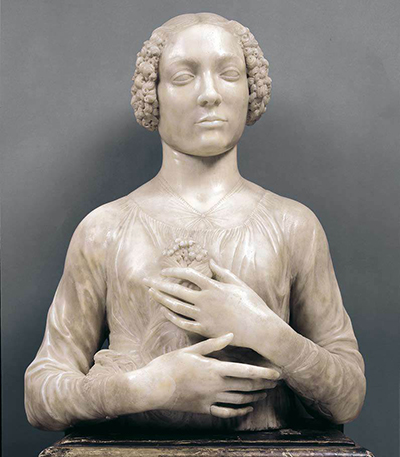Visitors to Florence often miss the Bargello museum. It seems unlikely that this is due to the palace's former life as a barracks, prison and place of execution, but perhaps its sculptures, majolica ware, tapestries and coins don't provide enough of a pull to busy tourists on a strict itinerary.
And although it displays the "big names", some of the works themselves are less famous. This is a shame, because they miss the chance to wander round in comparative peace, and to study at leisure such masterpieces as Donatello's David, Michelangelo's Pitti Tondo, and Cellini's bust of Cosimo de' Medici.
They also lose the opportunity to view the exquisite marble bust of Lady with a Bouquet, produced by Andrea del Verrocchio(1435-88) between 1475 and 1480. They won't appreciate, either, that this statue was the start of a new and innovative style for Renaissance figures, where the subject's arms are visible in ancient-Roman fashion, allowing the model to express emotion and individuality through both hands and face. Indeed, in Italian the piece is known as either Dama col Mazzolino (Lady With Bouquet) or Gentildonna dalle Belle Mani (Gentlewoman with Beautiful Hands). This influenced emerging artists like Verrocchio's one-time pupil Leonardo da Vinci, who went on to produce Studio di Mani (Study of Hands), a greater fluidity in figures, and his figura serpentinata or serpentine twisting.
Leonardo worked with Verrocchio in the latter's Florentine studio at a time when the older man was considered a major artist. Although Verrocchio is better known for his statues, a few paintings do exist, some of which were worked on by his students, with the only one that can be attributed to him for sure being the Uffizi's Baptism of Christ (and even that includes finishing touches by da Vinci). The master also positioned draped models for preliminary sketching before painting, helping to suggest volume on the finished canvas.
Verrocchio used his workshop to develop his sculpting technique, bringing terracotta to the fore as a prestigious artistic material, always eager to investigate new techniques. His winning model for a tribute to Niccolò Forteguerri in Pistoia, was an early example of its kind, starting a tradition that lasted until the eighteenth century. The intricate relief conveys a vitality and sense of movement more likely to be found in a sketch.
Other English titles for this 60 cm-high bust are Lady with Primroses, and Woman Holding Flowers. At the time, the hands held across her chest were an unusual feature, and they give the figure a quite different feel. Unlike the vibrant terracotta rendering of Giuliano de' Medici from the same period, this portrayal in marble is idealised and appears to keep the viewer at a distance, in what would be recognised as a defensive pose today. However, the positioning of the hands suggests emotion and vulnerability, and allows a glimpse of the real person to slip through the reserve.
It has been suggested that the sitter could be Giuliano's wife Fioretta Gorini, or Lucrezia Donati, the platonic love of Lorenzo il Magnifico, or even a woman from a da Vinci portrait. Verrocchio was a favourite with the Medici family, and the patronage of Lorenzo and his son Piero allowed the sculptor to constantly experiment and innovate, both in Florence and away from it. Perhaps it was growing up with a father who was a Florentine tile maker that led his son to train as a goldsmith, and then to work largely with marble, clay or bronze.
Andrea del Verrocchio was one of the most important sculptors working with reliefs during the Renaissance. He was more interested than his contemporaries in expressing movement in the materials he worked with, and was always ready to take on new challenges and techniques, even if it meant travelling to another city. The Lady with a Bouquet marked a significant point in his experimentation, and in the artistic development of the fifteenth century, and that is still recognised today.




